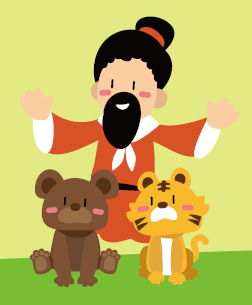Similar to other countries, Korea has a National Foundation Day named Gaecheonjeol on October 3. The aspect that slightly differentiates this from similar occurrences in other countries is that it is not the founding day of the modern state of Korea, but that of the first country on the Korean Peninsula—Gojoseon. There is also an amazing story, “Dangun Myth,” about this special day. What is Dangun mythology and what does this mean? The UOS Times takes a deep look at everything related to this founding myth and the interesting birth myth of other countries.

Story Behind the Dangun Mythology
Dangun Mythology became well-known among Korean people. The story has been passed down from one generation to another and has been recorded. Over the years, some parts have been deleted and some have been added, but it is still not entirely fiction. The story reflects the thoughts and surroundings of the people of that time, thus the historical significance and stories are hidden in their way.
First, the country founded by Dangun was originally named Joseon. However, in an effort to differentiate Joseon from the Joseon Dynasty founded by Lee Seong-gye in 1392, experts later altered it to “Go-” (old, in English) Joseon to signify “ancient Joseon.”
Second, multiple experts have noted that a bear transforming into a human may be referring to an instance wherein a bear-worshiping tribe defeated a tiger-worship tribe. Gojoseon was founded by combining the Hwanung tribe, which insisted on their status as the descendants of God, and the bear tribe, which uses bears as a totem. According to the myth, Hwanwoong came from heaven; however, it is assumed that the Hwanung tribe had simply moved from another area. The bear tribe must have been the original residents of the area. The two tribes merged and the son, Dangun, opened a new world.
Third, the representatives of wind, clouds, and rain that Hwanwoong brought along refers to the fact that farming was very important in Gojoseon. Because the climate is the most important factor for farming, people needed someone who would partake in weather-related tasks.
Other Birth Myths
After Gojoseon, the Three Kingdoms Period was approaching and the myths of the two countries, Goguryeo* and Silla*, are similar wherein both progenitors were born from eggs. Jumong, the founder of Goguryeo, was the child of Haemosu, the son of the creator, and Yuhua, the daughter of Habaek (who is the God of the Sea). Yuhua, who was expelled by Habaek because of an illicit love affair, was taken care of by King Geumwa of Buyeo. Soon, she laid an egg and a baby was found inside the egg.
The birth myth of Silla started with six villages that dispersed power. One day, there was a white horse kneeling and crying in the woods, beside the well. As the chiefs of the six villages approached, the horse flew into the sky and only one big egg remained. When they broke the egg, a baby came out of it, and this is baby is known as Park Hyuk Geo-se. The myth about being born from an egg is untrue and is simply a mythical element to emphasize the extraordinary birth and power of this historical figure.
The UOS Times have examined different parts of the history of National Foundation Day in Korea. Korea’s first nation and the meaning behind the nonsense story have been introduced. There are various myths surrounding Gojoseon, Goguryeo, and Silla, which later appeared. The Dangun mythology was used to designate a national holiday—Gaecheonjeol—in Korea, thereby inheriting its significance because it was the first time. It would be great if this article helped you to understand more about the National Foundation Day and the interesting history of Korea.
*Goguryeo: A country founded in 37 B.C. by Jumong of King Dongmyeong. During the era of King Gwanggaeto, it was occupied from the Korean Peninsula to the Liaodong region, and was destroyed in 668.)
*Silla: A country founded in 57 B.C. by Park Hyuk Geo-se in the present-day Yeongnam region. During the late 7th century, it overthrew Baekje and Goguryeo and unified the three kingdoms. However, in 935 B.C., it was ruined by the Goryeo Dynasty.)

Gojoseon—Korea’s First Nation
Dangun mythology is a myth about Dangun, who founded Korea’s first nation—Gojoseon. Gojoseon was established in 2333 B.C. and is currently located in North Korea and Manchuria. It was originally founded based on the Bronze Age and later accepted ironware, thus becoming stronger. The primary social rule of Gojoseon is “Article 8,” which considered the necessity of people’s lives, labor, and property and these rules came down until now.
Gojoseon got wealthy through transit trade between the Jin Dynasty in the southern part of the Korean Peninsula and the Han Dynasty of China. However, it was on the road to collapse in 108 B.C. and was thus defeated in the war against the Han Dynasty.
Dangun Mythology(The Birth Myth of Gojoseon)
A long time ago, Hwanung, the son of the God Hwan-in, loved the human world. He led 3,000 servants and the representatives of rain, wind, and cloud to Earth in an effort to make people comfortable. He built a town named Sinshi under the tree Sindansu. One day, a bear and a tiger asked him to transform them into humans. Hwanung replied, “If you eat mugwort and garlic, and endure 100 days in a cave, I will make you human.”
However, the tiger gave up, and only the bear eventually became a human woman. Hwanung married the bear (Wungnyeo) and gave birth to a son named Dangun. Dangun founded the country on Taebaek Mountain and named it Joseon. He is also called Dangun Wanggeom. Dangun refers to a religious leader, and Wanggeom refers to a political ruler. Gojoseon’s founding ideology is “Hongik Ingan” (humanitarianism, in English), which translates to: “Be well benefit the people.’’.
Park Ji-yeong
vipp0925@uos.ac.kr

